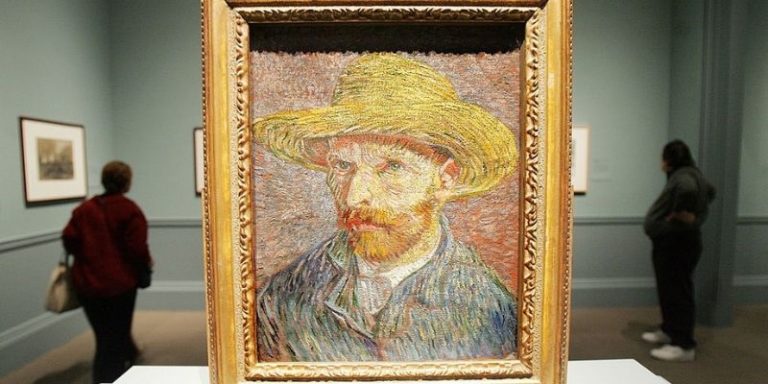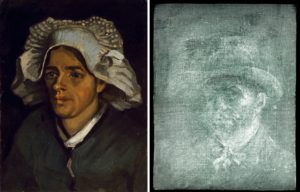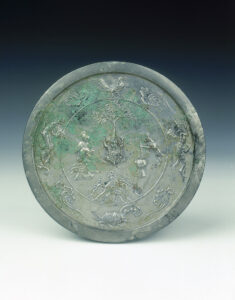Hidden Art Is Being Discovered Around the World
Enthusiasts and museum curators are uncovering art we didn’t know existed.
By: Kirsten Brooker | August 11, 2022 | 807 Words

A Vincent van Gogh self-portrait (Photo by Mario Tama/Getty Images)
Art has captivated audiences for eons. From paintings like the Mona Lisa to life-size statues, art expresses human feeling and experience. But what if there were more to the story? Recently, hidden art has been discovered within other artistic pieces, as well as microscopic art that cannot be seen with the naked eye. These exciting finds are piquing the interest of museums and art-lovers worldwide.
Van Gogh’s Hidden Portrait

‘Head of a Peasant Woman’ (left) and x-ray of Van Gogh’s self-portrait (right) (Photos by: The National Galleries of Scotland)
Vincent van Gogh is a well known Dutch painter from the 19th century. He is most famous for his “Starry Night” and “Sunflowers” paintings. In 1885, he revealed a piece named “The Head of a Peasant Woman.” For a long time, that was that. Recently, a whole new piece was discovered hidden behind the peasant’s portrait. Upon closer examination of the artwork, conservators at the National Galleries of Scotland realized there was more to the image than first thought. An X-ray of the picture uncovered a hidden self-portrait of Van Gogh himself under the otherwise modest painting.
Senior Conservator Lesley Stevenson expressed the excitement museum staff felt when the concealed portrait was discovered. “It was absolutely thrilling,” she said. “We don’t see much of the peasant woman, but what we have is the lead white, the much heavier pigment [Van Gogh] used for his face, showing up after the X-ray goes through the cardboard.”

A bronze mirror Tang dynasty, China, 8th century.
Van Gogh was known for creating self-portraits, and it is believed that he did so to practice his skill without spending extra money on models. Art historians hope to use the newly discovered piece to learn more about Van Gogh and his life.
A Secret Buddha
Nearly 4,000 miles away, a bronze mirror from 16th century Asia sat in storage for decades at Cincinnati Art Museum in Ohio. Hou-Mei Sung, a curator at the museum, wanted to finally display the artifact for visitors. At first glance it appeared to be a simple bronze disc with an inscription of the Buddha name, but research gave Sung a hint there could be more to the mirror than she had thought. She uncovered its magical qualities when she shone a light on the disc. The light revealed an image of Buddha sitting in his typical meditation pose within the bronze.
“We do not have too many Buddha statues. So I found this Buddhist prayer sort of a mirror. I thought it could be displayed. And then I started research. And that’s how I found one magic mirror with similar characteristics in other museums,” Sung told Artnet News. “It’s really fate or luck,” she said. “We were going to put the bronze artwork on view in a museum gallery. Out of curiosity, I wanted to test it.”
Sung could not determine whether the mirror was made in Japan or China. However, the museum said that magic mirrors were first created in China during the Han Dynasty, which ruled from the year 206 BC to 220 AD. “When light is projected on them, the mirrors appear transparent and reveal characters or a decorative design,” Sung said.
It Does Exist!

British microsculpture artist Willard Wigan sits in front of a microscope in the exhibition “Kleine Welten” (Tiny Worlds) (Photo by Maja Hitij/picture alliance via Getty Images)
A microscopic Tyrannosaurus Rex sculpture is displayed at a Nottingham Museum in England. The miniature T-Rex was created by artist Dr. Willard Wigan and it fits within the eye of a needle. The tiny dinosaur is being displayed next to a real T-Rex skeleton and the difference in size between the two exhibits is astounding, since the sculpture is only 0.5mm (0.01 inches) in size. The only way to see it is through a microscope! Rachael Evans, a manager for the city’s museums, said: “It is an astonishing moment for us. We have one of the largest dinosaurs ever exhibited in the UK on display alongside one of the smallest.”
Wigan’s motivation for the tiny dinosaur replica was to reflect on the saying that just because you cannot see something does not mean it doesn’t exist. After all, dinosaurs still existed before they were discovered by humans. Wigan used the latest known information to create the most exact version of the meat eater possible.
City officials and museum curators are thrilled to display the new hidden art, saying they hope the exhibit “will create interest in natural science and culture in young people.”
It seems the world of art has lots of discoveries waiting to be made. What might be found next?
















